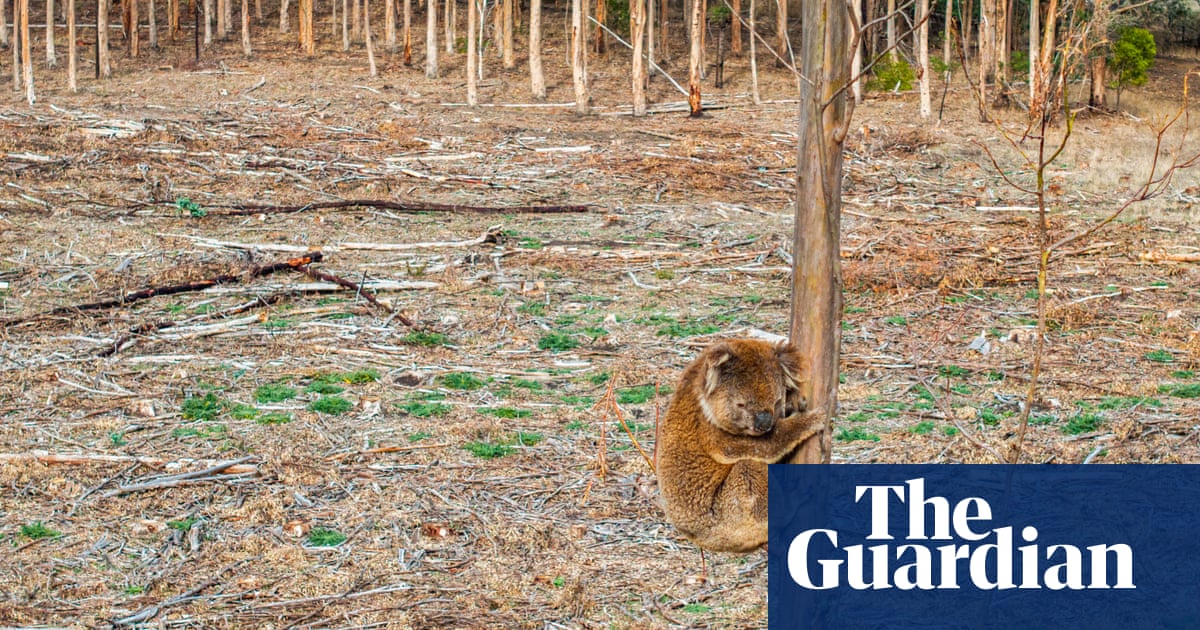Thousands of koalas are being displaced each year as blue gum plantations are cut down in Victoria, worsening overcrowding in nearby forests and exacerbating the risk of injury and death during bushfires.
An estimated 42,500 koalas live in blue gum plantations in south-west Victoria, data shows. Between 8,000 and 10,000 hectares of plantation are harvested each year, making thousands of koalas homeless.
Scientists said the displaced animals crossed roads used by logging trucks. They moved into trees along road reserves, on neighbouring properties and nearby forests, which they soon strip bare. Some migrated into adjacent plantations, only to be evicted again the following year.
“It’s a pretty stressful situation for koalas,” said Deakin University ecologist Dr Desley Whisson, who specialises in koala management. “The blue gum plantations get cut down, and those koalas have to find somewhere to go.”
Each year thousands of koalas were likely displaced by plantation harvests, she said, based on their density in plantations and the scale of the logging.
Koalas are listed as endangered in New South Wales, Queensland and the Australian Capital Territory, but in south-west Victoria and South Australia there are not enough trees to sustain the koala populations.
The CSIRO estimates the national koala population is between 224,000 and 524,000.
Whisson said koalas displaced from blue gum plantations were adding to already high densities in nearby trees and forests and contributing to the decline of nearby native vegetation, like manna gum. Overabundance, particularly combined with drought or fire, could ultimately lead to welfare issues – mass starvation and death – with land managers and wildlife carers left to deal with the consequences.
One licensed koala shelter operator in the south-west, who asked not be named, said she helped up to 450 sick or injured animals a year. She said displaced animals were sometimes still up in trees that were felled and ended up with broken bones, or were orphaned babies left behind. Others were attacked by cows or dogs.
She said some koalas froze in the lights of logging trucks while crossing roads. “The amount of road kill is just horrendous,” the carer said. “They’ve been in a huge, big forest all their life. And then all of a sudden it’s ripped down around them.”
A 2023 study of reported wild koala deaths in south-east Queensland found vehicles were responsible for about half (1,431) of all fatalities.
The Victorian government released its koala strategy in May 2023. It detailed koala welfare problems associated with plantations but did not focus on long-term solutions.
“There are currently no cost-effective management techniques available that would be acceptable to the community, or clear objectives for the management of koalas in blue gum plantations,” the strategy said.
Victoria’s environment department said it was working with animal welfare groups and experts to ensure the sustainability of koala populations and had invested $3.3m in koala management and research.
“Victoria is fortunate to have a large koala population, but it does face threats such as disease, climate change and poor genetic diversity in some of the populations,” a spokesperson told Guardian Australia.
after newsletter promotion
Dr Kita Ashman, an ecologist for WWF Australia, said the plantations had changed the landscape profoundly since being established in the 1990s and 2000s.
She said the blue gum leaves provided a nutritious source of food that enabled the animals to reach much higher numbers than normal, but no one had properly dealt with the ramifications. The plantation industry was required to obtain a permit before it disturbed koalas, to engage koala spotters and to retain a minimum of nine trees around any animal observed during harvesting, but there was little onus on it to consider the fate of displaced animals, she said.
“We’re basically planting up this smorgasbord of plantations that koalas then move into, feed on, breed in,” she said.
But Ashman said the answer should not be to get rid of plantations, as they were an important alternative to the native forest logging industry.
Whisson said it was a “wicked problem” that was likely to get worse. But she said there were solutions at the landscape scale that could improve the situation. They included the blue gum industry leaving a portion of each plantation for koalas to stay in or contributing to restoring permanent habitat. They could also provide support for wildlife carers and animal hospitals dealing with the fallout.
She said that in the longer term the industry could consider growing an alternative tree species that was less palatable to koalas than blue gum.
Koala ecologist Dr Rolf Schlagloth, from Central Queensland University, said providing somewhere for the koalas to go was a “solvable problem”.
“The real issue is the lack of connectivity [of nature] and failing to properly manage koala habitat,” he said.
Schlagloth said all stakeholders needed to be involved in finding solutions and that state and federal governments needed to acknowledge mistakes – and it would take significant effort, and funding, to fix them.
“We need open, honest discussion,” he said, “to make sure that our koalas – which are a flagship species – are saved.”

